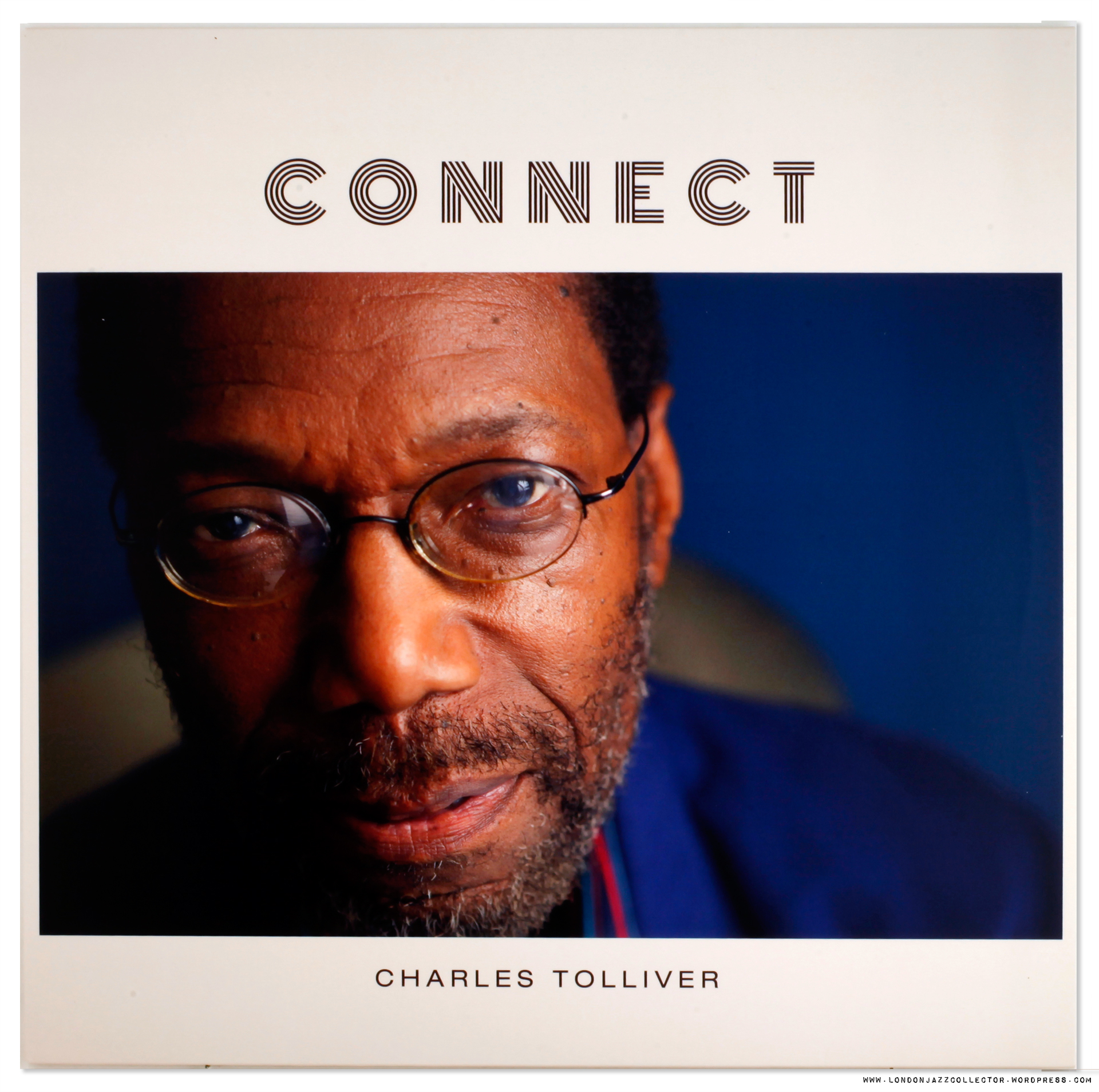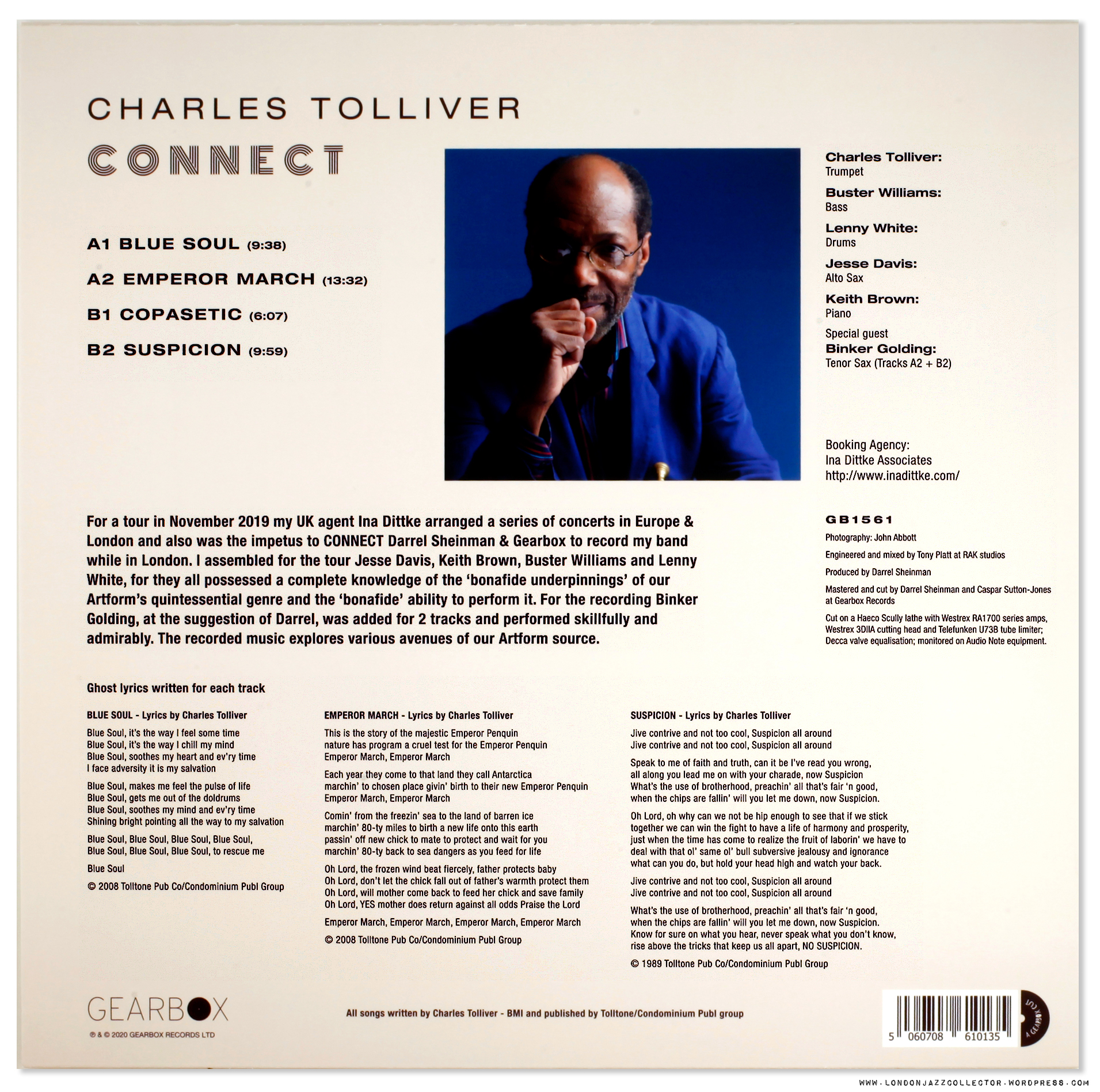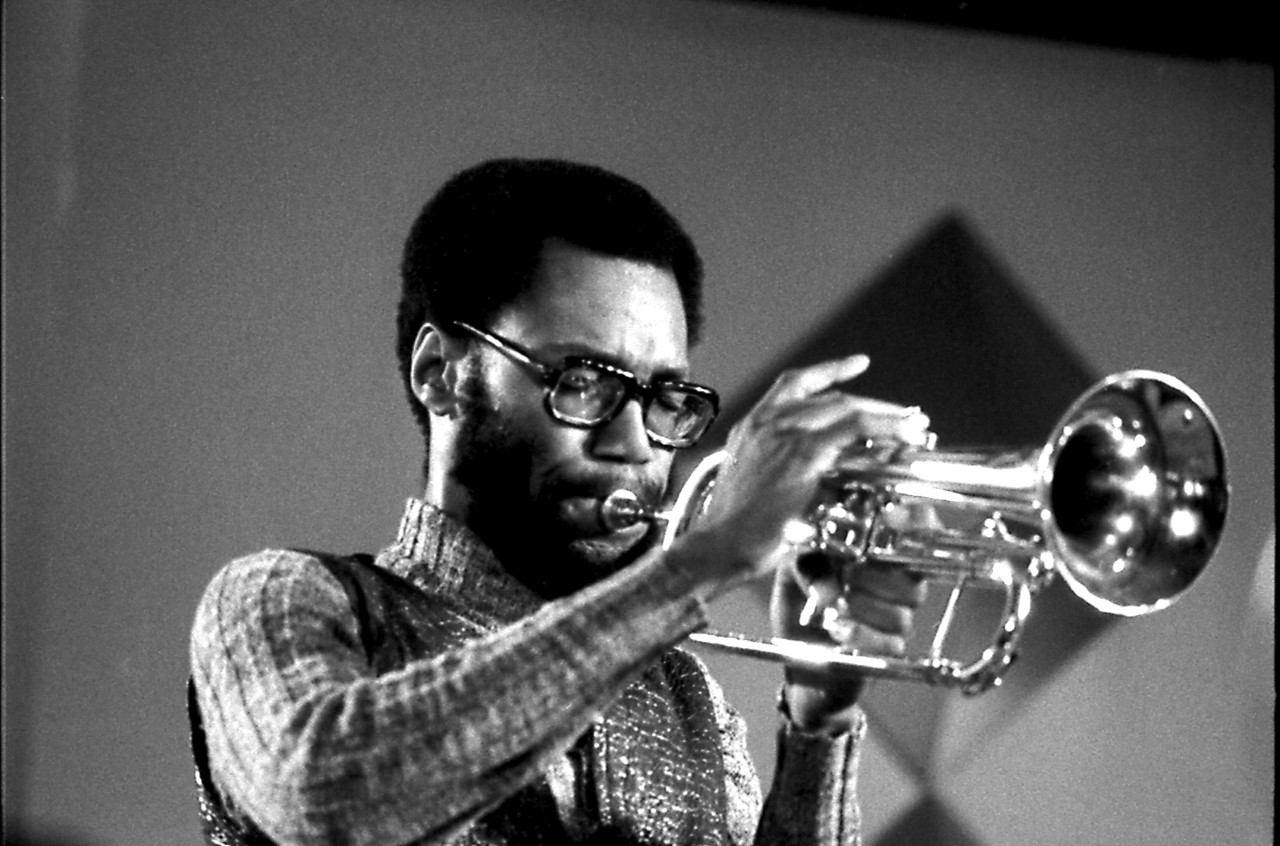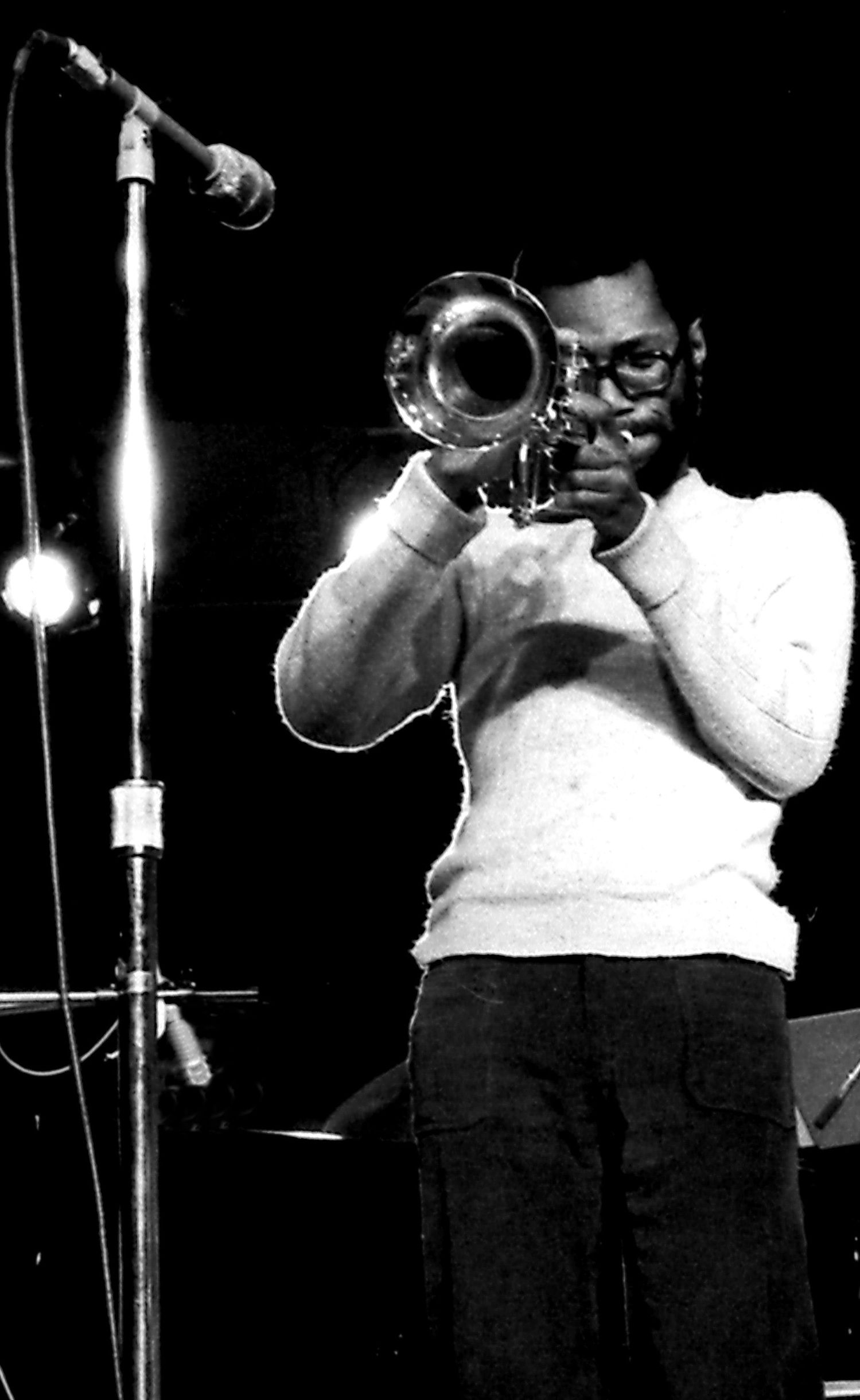Given the interest in Charles Tolliver following a recent Strata East post, I’ve brought forward a piece on Tolliver’s recent album, Connect, recorded for Gearbox Records in London in 2019.
Selection: Emperor March
. . .
Track List
-
- Blue Soul 9:38
- Emperor March 13:32
- Copaestic 6:07
- Suspicion 9:59
“Tolliver has a deeply touching take on hard bop and modal jazz whereby the themes are soulfully yearning, none more so than the gorgeous sway of ‘Emperor March’ (Jazzwise, five stars)
It is over ten years since Tolliver’s last album, a big band arrangement entitled Emperor March (same titles as the selection), recorded live at The Blue Note in New York. Released unfortunately only on CD.
“Emperor March” I guess refers to the remarkable and moving wildlife documentary March of the Emperor Penguin (2005) symbol of will and determination to survive a long journey, a metaphor for life, (though the Antarctic Emperor penguins do it for nookie, marching up to 70 miles over ice to reach a breeding colony, mostly with a different mate each year. Low fidelity!)
Artists
Charles Tolliver, trumpet; Jesse Davis, alto saxophone; Keith Brown, piano; Buster Williams, bass; Lenny White drums; Binker Golding, tenor saxophone (B, D); recorded at RAK Studios, London, November 2019; engineer Tony Platt.
At the age of 78, Tolliver’s career spans over five decades, one of the dwindling number of jazz elder statesman still performing. British Tenor player Binker Golding, an extended free jazz improviser, was added at the recommendation of Gearbox boss Darrell Sheinman, who has released three albums of Binker’s sax/drums duo with Moses Boyd. Sax and drums, no bass, too sparse for me, but some clearly like it.
A “second-wave” hard bop player, Tolliver’s earliest appearances on record included Jackie McLean’s It’s Time (Blue Note, 1964). In 1971 he co-founded the mighty Strata-East label with pianist Stanley Cowell. Just as Blue Note marked the evolution of bop, post bop and modal jazz, Strata East marked the 1970’s intersection of hard bop and spiritual jazz with a side-order of soul. Many Strata East titles were recorded at Minot Sound, a New York recording studio run by Ron Carran, engineer responsible for the high quality of Strata East recordings. Carran deserves more mention in the Engineering Hall of Fame.
Music
Gearbox has a specialty niche of releasing historic BBC jazz recordings from the 50’s and 60s, and is one of just a handful of studios offering pure analogue mastering, alongside the likes of Abbey Road and Air Studios (Ray Staff for Pure Pleasure) They boast an original Scully lathe in their own mastering studio at Tileyard, Kings Cross, London. Mastering is by Caspar Sutton-Jones, who’s excellent track record includes cutting the superb Tubby Hayes vinyl reissue boxset. He signs his cuttings CASPAR.
Tolliver was recorded at RAK Studios, St John’s Wood, by Tony Platt, an English freelance engineer with a forty year track recording mostly British elite rock and pop (electric guitars) , with some jazz and blues. My first reaction listening to the vinyl was not very favourable – compressed, over-engineered, rather murky, lacking musicians-in-the-room presence. According to Platt’s Linked-In profile, his philosophy is “ enhancing music by the use of technology”. Not faithfully recording the instruments then, enhancing the music, whatever that means, but enough to get him a lecturing place at Northampton University.
Together with the former head of marketing of Gearbox Records, Platt co-founded the Jazzlotion company, “dedicated to recording young jazz musicians in a state-of-the-art environment, for release on four track EP downloads”.
“Progress through technology, state of the art, downloads…” rings all the wrong bells for me. I can’t hear any progress, stuff recorded fifty years ago sounds much better than this.
Here’s my problem. Jazz has a unique language and legacy that is all its own. My baseline is listening on vinyl to hundreds if not thousands of recordings by Van Gelder ( home studio in parents house, Hackensack) , Roy Du Nann (Contemporary offices stock room), Fred Plaut (converted church), Fred Carran, countless unnamed others from the golden age, engineered for analogue, on comparatively primitive equipment, with stunning results, musicians-in-the-room. I know only what I hear, Platt’s recording is just not very good, judged by vintage standards. I’ve no axe to grind. There has been no progress, merely engineers falling in love with control tools and interfering with sound in the mistaken belief they are “improving it”. Never believe your own Linked-In Profile. Nor indeed anyone elses.
Art Director’s Lunch Break
We are fussy about art direction here. Gearbox’s Connect announcement provides a photo of Tolliver in the recording studio. A lost opportunity to show which microphone was in use, think Sound of Sonny Rollins with a Neumann U47, where the mic is the hero.
A few lessons on composition and lighting from Francis Wolff might help. Look at the photo below and notice your eyes wandering around inside the frame. Three quarters of the image is noisy contrasty background, shallow depth of field spill-over which serves no useful purpose. And there is a distracting blurred “gizmo” on a tripod behind the horn bell. I was drawn to figure out what it is, perhaps someone knows.
Tolliver is not actually playing the horn, it’s resting against his chin, he is posed. The picture however does have potential. Tolliver’s hand gripping the horn, fingers on the valves, would make a perfect focal point, but the whole picture needs to be heavily cropped to make it work. There is a compressed tonal range, a lot of grey, no true black shadow or white highlight detail . See Harry’s Place below for examples of how it should be.
Is the art director back from lunch yet? It’s four o’clock.
(Photo credit: Pete Gardner)
Harry’s Place
Harry M has the photos, shows how it should be done, beautiful. Montreux 1971 with Max Roach and the University of Northern Colorado Big Band. I guess shot on 400 ASA Kodax Tri-X film, pushed a couple of stops, judged by the grain.
Collector’s Corner
Tolliver’s Music Inc. fifty years ago: doesn’t jazz sound a little more fresh than today?
The opening track, Blue Soul, was a rival for the selection (YT below), but it’s development is slow and repetitive. When it eventually kicks in, we get a lightweight horn riff, too laid back for me, it needs more fire after that long dramatic build up: tension demands release. This recording needed a Producer with a firm hand to knock it into shape: another modern skill shortage to add to engineering and art direction. You begin to understand why Blue Note remains the gold standard: you can’t just leave it all to the musicians.
However we can be grateful to have Tolliver still with us and performing. Fans will welcome him back. I must get my hands on some Tolliver Strata East. That’s fifty year fresh sounds, great.
Any thoughts on Gearbox, Strata East,Tolliver, or even randy Emperor Penguins, welcome.









I was at Bowling Green State University 1969-70. The only jazz event was a visit from a quartet featuring Stanley Cowell and Charles Tolliver and the BGSU BigBand (students). I had never heard of them before but followed them subsequently on LP.
On Fri, 4 Jun 2021 at 11:11, LondonJazzCollector wrote:
> LondonJazzCollector posted: “Given the interest in Charles Tolliver > following a recent Strata East post, I’ve brought forward a piece on > Tolliver’s recent album, Connect, recorded for Gearbox Records in London in > 2019. Selection: Emperor March . . . Track List Blue So” >
LikeLike
Hearing about your woes with the Gearbox work on this record has given me an unexpected dose of nervousness about the forthcoming Decca “British Jazz Explosion” re-issues. We’re due a two-LP compilation plus Don Rendell’s Space Walk, Kenny Wheeler’s Windmill Tilter and NJO’s Dejeuner Sur L’Herbe. They’re all billed as “Vinyl audio remastered & cut from the original master tapes by Gearbox Records” onthe Decca website.
Hopefully this is unfounded and things will return to the quality of their previous work.
LikeLike
Your nervousness should prove unfounded since LJC’s issue with this album seems to be the recording as opposed to the mastering. The Tubby Hayes box set is perhaps a better reference point when it comes to setting expectations for the upcoming Decca reissue series.
LikeLike
Martin, Thanks for the heads-up on these Decca releases. I wasn’t aware of them. Something else to look forward to.
LikeLike
You’re welcome Alun. I think some sort of late-Covid damburst may be about to happen with jazz re-issues. We’ve got these Decca ones, I recently received my copy of the Jazz In Britain Rendell-Carr Quintet release and there’s the humungous Lee Morgan Live At The Lighthouse box set on the way. On top of all that, it actually looks as though there are some interesting jazz items in the Record Store Day 2021 list including a Mike Taylor record and a live Roy Brooks item of similar vintage to his The Free Slave LP that came out on Muse.
LikeLike
Boy, this one caught you in a sour mood, LJC. Platt can’t record worth a damn; the photographer doesn’t know his arse from his wide-angle; there’s no sexy microphone shot!
Well, I’ve been in a sour mood recently too. A good number of records have disappointed me and have been returned — usually because of pressing faults.
But one exception to this has been a Gearbox record — the marvellous, late addition to Abdullah Ibrahim’s body of work, THE BALANCE. Beautifully presented; gatefold sleeve; well engineered and pressed. (I suspect you would quibble with the full-spread inner gatefold picture of AB, however, which looks to me as if it needs some colour correction to address a green spot somewhere out of shot.) Anyway, I think Gearbox has done Abdullah Ibrahim proud on this. And to have the valiant elder statesman of township jazz still producing vital and necessary music in his 80s is cause for celebration.
LikeLike
Alun, I always appreciate your comments. You have caught me in a philosphical bind. Until recently I would write about only records I felt excited and positive about. Heaps of praise, everyone was happy.
However, I am trying to widen the scope of reviews, include records which I don’t particularly like, or I think have a weakness, in composing, playing, arranging, recording, mastering, pressing, or art department. though they have overall merit. It is not due to feeling grumpy. I think Tolliver’s Connect is not very well recorded, he deserved better, people are free to disagree.
LikeLike
No disagreement here — I’m in favour of covering the less good as well as the great. It extends the palette.
LikeLike
I have to agree with you on the sound and admit this was one occasion I was thankful for a faulty pressing. I’ve invested so much in great jazz titles this last couple of years that I’d seriously doubt this would have been played more than a couple of times; engineering managed to completely suck the life out of the recording, shame that. Still, the recently acquired Tone Poet, It’s Time, more than compensates.
LikeLike
Gearbox has been quietly releasing some incredibly fantastic releases over the years, I’ve snatched up as many of the Tubby Hayes as I can get my hands on. All are worth having and they get plenty of table time in my listening room!
LikeLike